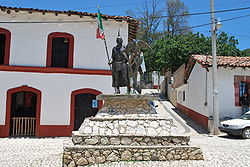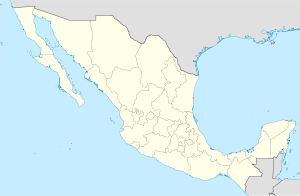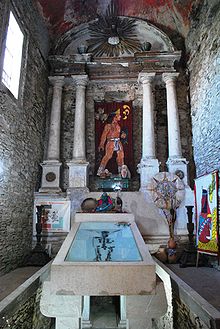- Ixcateopan de Cuauhtémoc
-
Ixcateopan de Cuauhtémoc
Ichcateopan— Town & Municipality — Monument to Cuauhtémoc in a plaza in the town Location in Mexico Coordinates: 18°30′00″N 99°47′36″W / 18.5°N 99.79333°WCoordinates: 18°30′00″N 99°47′36″W / 18.5°N 99.79333°W Country  Mexico
MexicoState Guerrero Founded 350 Municipal Status 1850 Government – Municipal President Dario Perez Morales (2007–2010) Area – Municipality 310.7 km2 (120 sq mi) Elevationof seat 2,600 m (8,530 ft) Population (2005)Municipality – Municipality 6,104 – Seat 2,379 Time zone CST (UTC-6) Postal code (of seat) 40430 Demonym Ixcateopan de Cuauhtémoc is a town and municipality located in isolated, rugged mountains in the northern part of Guerrero state, Mexico. It is best known as the final resting place of AztecEmperor Cuauhtémoc, whose remains were found under the parish church here in the mid-20th century. This church has been converted into a museum with displays a number of pre-Hispanic artifacts, offerings left in honor of the emperor and the remains of Cuauhtémoc himself.[1]
Ixcateopan de Cuauhtémoc is located 36 km west of famous silver town of Taxco de Alarcón, traveling on the state highway. Unlike its neighbor, the vegetation surrounding Ixcateopan is forested with pine, red and white cedar, and walnut trees. Along the highway, there is a waterfall by the name of Cascada de Cacalotenango, which has a small chapel at the top.[2] The distance between Ixcateopan and Chilpancingo, the capital of the state of Guerrero, is 180 km.[3]
The name Ixcateopan (sometimes spelled Ichcateopan) from the Nahuatl words “ichcacates” (or “ixcatle”) and “moteopan,” “teopan,” or “teopancalli.” Most interpret the first word as meaning cotton and the second temple, leading to a translation of temple of cotton. However some sources claim the real name of the area is Zompancuahuithli, and the name was changed to Ixcateopan after the arrival of Cuauhtemoc's body and means (here is the temple/church). The glyph in the Mendoncino Codex for Ixcateopan reflects both interpretations, a cotton flower, a depiction of Cuauhtémoc and a pyramid.[4][5] “De Cuauhtémoc” was added to Ixcateopan’s name by the Congress of the State of Guerrero in 1950.[5]
Contents
History
Some of the inhabitants of this area before the Conquest were the Cohuixas and the Chontals. The indigenous community located at what is now the southern edge of the town dates back to at least 350 C. E. This community was an important regional ceremonial center as well as the headquarters for the guardian soldiers. It was also closely associated with the production of cotton and cotton products, a valuable commodity at the time. Ixcateopan was one of the last cities to be subjugated by the Aztec Empire. The location served as a point to gather and then distribute tribute from surrounding areas. Mexica from other parts of the Aztec Empire, including soldiers, came here due to the wars between them and the P'urhépecha empire. Because of this, Ixcateopan, originally a purely Chontal city, became multicultural.[4][6]
Cuauhtémoc, the last Aztec emperor, was born here in 1501. His mother, Cuayauhtitali, was the daughter of the lord of Ixcateopan. Shortly before Cuauhtémoc was born, Ixcateopan was subjugated by the Aztecs and Cuayauhtitli was captured and brought to Tenochtitlan. There she met prince Ahuizotl, who married her. Cuahtémoc was born of this union. Cuauhtémoc was educated in Tenochtitlan and then sent back to Ixcateopan. In 1519, he was called back to the Aztec capital to help defend it against the Spanish. After the deaths of Emperors Moctezuma II and, a short time later, Cuitláhuac, Cuauhtémoc became emperor, but was a captive of Hernán Cortés when Tenochtitlan fell in 1521. After enduring much torture, he and nine other Aztec lords were hung near a place called Izancánac in what is now Chiapas state.[1] The remains of Cuauhtemoc, the other Aztec lords and a priest who opposed their execution were brought to Ixcateopan and buried here.[7] From that time to the mid-twentieth century, the whereabouts of his tomb remained unknown.[1]
Fray Torbio de Benavente, the local evangelist, and Fray Bernardino de Sahagún wrote texts about the death and burial of Cuauhtémoc which were initially kept at the Church of San Hipólito in Mexico City but somehow wound up in the hands of the family of Salvador Rodriguez Juárez, who was the doctor of Ixcateopan in the first half of the 20th century.[7] The documents had been passed down in his family for generations. They told of how Cuauhtémoc’s body had been recovered and brought to Ixcateopan and initially buried at the palace of his maternal grandparents in 1525. In 1529, Fray Toribio de Benavente had the body moved to a spot in front of the destroyed pagan temple, where the Church of Santa María de la Asunción would be built over him. The documents indicated that this tomb was nearly directly under the main altar of the church. After Rodríguez Juárez showed the documents to elders at the parish church, the Instituto Nacional de Antropología e Historia (INAH) was contacted, which sent archeologist Eulalia Guzmán to investigate the authenticity of the documents. After examining the documents, investigating the oral traditions of the area and other archeological and historical evidence, it was decided to excavate in the place where the documents indicated.[1]
From February to September 1949, other investigations corroborated the story related by the documents. The main altar of the church was dismantled and taken away and began to excavate below it. They dug about 1.5 meters down, found a rock layer, which covered a multitude of burials which dated from the early colonial period. Another meter or so down, they found a layer of stucco and adobe bricks, then a layer of large rocks with spaces between them filled in by smaller ones, called a momeztli. Underneath this was a cavity with an east-west orientation were the remains of several bodies dating from the 16th century. Underneath these was another cavity covered in an oval copper plate with the inscription Rey e S. Coatemo. (“rey” means king in Spanish and Coatemo as an alternative spelling for Cuauhtémoc) Underneath this were other bones, a spear-point, other pieces of metal and remnants of objects long ago rusted. The discovery of Cuauhtemoc’s tomb was announced on 26 September 1949.[1]
The authenticity of the find was challenged, so the INAH sent other teams to investigate the find. Results of the corroborative efforts were mixed with researchers casting doubt on the age of the bones found, the documents that led to their discovery and the authenticity of the artifacts found at the site. However, over time and with new testing techniques, these objections were overcome one-by-one and by the 1970s the find had become accepted as genuine.[1]
The town
The town of Ixcateopan has about 2,400 residents, which is over a third of the municipality’s inhabitants.[8] One thing that stands out about this town is that streets are paved in unpolished white marble and many of the walls around properties contain it as well.[2] The town of Ixcateopan has similar colonial architecture as the larger Taxco: white houses topped with peaked roofs with red clay tile roofs; however, they are not as well-maintained as those in Taxco.[7] Because of the discovery of Cuauhtémoc’s tomb here, Ixcateopan has become a place of national interest. Flags fly here at half mast on 28 February, the anniversary of Cuauhtémoc’s death.[5] Because of the discovery of the tomb of Cuauhtemoc and the continued discoveries at the archeological site on the southern edge of town, Ixcateopan draws archeologists, anthropologist and historians.[6][7]
Museum of Santa María de la Asunción
The Museum of Santa María de la Asunción, located just south of the main plaza in the center of town, was the parish church for the community from the 16th century until the mid-20th, when it was declared a national monument. Since the discovery of Cuauhtémoc’s tomb under the main altar, this building and its grounds have been converted from a religious sanctuary to a civil one. Most, but not all, of its Christian iconography has been taken out. Where the main altar used to be is now a shrine to the last Aztec emperor, with his remains on public display. A small museum occupies the former church’s annex.[2][7] Jairo Rodríguez, son of the doctor who made the documents about Cuauhtemoc’s burial public knowledge, is the official chronicler of Ixcateopan and the guardian of the museum.[7]
Annual ceremony in honor of Cuauhtémoc
Cuauhtemoc has become a symbol of Mexican cultural identity and for many dancers who come here to celebrate, a symbol of their modern identity.[9] Cuauhtémoc has become a symbol of ethnocultural identity, nationalism and resistance, and this place brings indigenous people from all over Mexico and other nations in the Americas. The end of February is important as Cuauhtémoc’s birthday (23 February) and death (28 February) are commemorated here. His day of birth draws the most dance groups who come from all over Mexico, the U.S., Canada and South America, to lay offerings, dance and sing in many different languages.[7] Preparations at the church/museum and the rest of the town occupy the days and nights before the 23rd. For several days straddling the birthday itself, dances and ceremonies continue almost non-stop, accompanies by huehuetls (Aztec drums), and wind instruments made of animal horns and large conch shells and accompanied by copal incense.[9]
Archeological zone
South of the Santa María de la Asunción Museum on Vicente Guerrero Street is the archeological zone of Ixcateopan.[2] The site has been dated from between 350 and 1450 C. E. with at least five construction stages,[4] three of which are dated from between 1350 and 1450 C.E. Although construction seemed to have ceased after 1450, it is known that the site was occupied up until the Spanish arrival in 1521.[10] The archeological zone is formed by a series of constructions over a natural elevation and occupied about 5,000 metros2. Local materials were used in its construction: flagstone, limestone, marble and smooth pebble which were covered in stucco and painted. This excavated complex was dedicated to religious ceremonies, administrative activities and the local hierarchy’s relations with the rest of the world. Religiously, it was of regional importance.[4]
Ixcateopan was a Chontal settlement that was conquered by the Aztecs, by Moctezuma I and Ahuitzotl. The Chontales are a little-known group with most information about them coming from documents written in 1579, but nothing of their language is known as no human remains from their burials have been found. stages The site has provided much information about the development of what is now the north of Guerrero state in the late pre-Hispanic period, when it was populated by groups such as the Matlatzincas, Tepoztecos, Nahuas as well as Chontales.[10]
The site was first excavated in 1976 by archeologist Juan Yaveún, with subsequent studies by Guadalupe Martínez, Alajandro Pastrana, José Hernández Rivera and Elizabeth Jiménez.[10] However, excavations in the mid 2000’s have uncovered new finds at the site including a set of stairs that run from south to north on the main plaza, dwellings and storage facilities as well as workshops with ceramics showing Aztec and Cholulteca influence and purely local designs. With these, it is possible to reconstruct something of these people’s relations with these groups. Most of the excavations here have followed an east-west axis and about 3,000 m2 have been explored. Efforts have been made to have Ixcateopan and “archeological monuments zone” as well as obtain resources to continue excavations here.[6]
The municipality
The municipality of Ixcateopan is part of the northern region of Guerrero state. It borders the municipalities of Taxco, Pedro Ascencio Alquisiras and Teloloapan. As much of its 310.7km2 territory is on the Trans-Mexican Volcanic Belt, it consists of very rugged terrain. This has made the municipality and its seat relatively isolated, with the first major road reaching it in the 1940s. Higher elevations here are covered in pine and cedar (red and white) and include peaks such as the Texal Grande, Tecampanero, La Mesas and Ancón Mountains, which range between 1,830 and 2,150 meters above sea level. Only 15% of the municipality is flat land, and this is mostly small mesas scattered in the south and north east of the municipality. The municipality is in the Balsas River Basin but only streams such as the Atenanguillo, San Pedro Atengo, Salitre flow year-round. There is one major fresh-water spring at the municipal seat but the rest of the municipality depends on groundwater. The climate is warm and fairly moist, with average temperatures ranging between 18 and 22 C in the warmer months and between 17 and 22C in the colder ones. Most of the municipality’s rain falls between June and September.[5]
Unlike many other municipalities in Mexico, the population of Ixcateopan is falling. From 1960 to 2005, the population has valled from over 8,000 to 6,100. Most of the population is scattered among 70 “localidades” of between 2 and 1000, with most between 70 and 200 people.[5][8]
About 32% of the municipalities population is dedicated to agriculture of which the production of beans stand out, but livestock such as pigs, sheep, goats and horses are raised here as well. Another 38% is involved in mining and manufacturing with the primary commodities being marble and hand-crafted furniture.[5]
References
- ^ a b c d e f Quiroz Cuarón, Alfonso (2002) (in Spanish). Ichcateopan: La tumba de Cuauhtémoc – Héroe Supremo de la Historia de México [Ixcateopan: The tomb of Cuahtemoc – Supreme Hero of the History of Mexico]. Mexico City: Aconcagua Ediciones y Publicaciones, S. A.. pp. 2–15.
- ^ a b c d "Ixcateopan de Cuauhtémoc" (in Spanish). Mexico Desconocido Guerrero El Destino del Mundo (Mexico City: Grupo Editorial Impresiones Aéreas) 135: 85–86. May 2007. ISSN 0188-5146.
- ^ "Mapa Digital de México". http://galileo.inegi.gob.mx/website/mexico/viewer.htm?bsqTable=77&bsqField=CVEMUN&bsqStr=12037&TName=MGM&seccionB=mdm. Retrieved 2008-01-29.
- ^ a b c d "Ixcateopan" (in Spanish). http://www.visitingmexico.com.mx/turismo-en-mexico/arqueologico/tur-arqueologico-guerrero-ixcateopan.php. Retrieved 29 August 2009.
- ^ a b c d e f "Ixcateopan de Cuauhtémoc" (in Spanish). State of Guerrero. http://www.guerrero.gob.mx/?P=ixcateopan_de_cuauhtemoc. Retrieved 29 August 2009.
- ^ a b c 1 "Ixcateopan may be Declared Archaeological Monuments Zone". INAH. September 2008. http://dti.inah.gob.mx/index.php?option=com_content&task=view&id=1668&Itemid=150 1. Retrieved 29 August 2009.
- ^ a b c d e f g "Sigue viva la memoria de Cuauhtémoc en Museo de Ixcateopan, Guerrero [Cuahtémoc’s memory lives on at the Museum of Ixcateopan, Guerrero]" (in Spanish). Notimex. 2009-08-25. http://www.turista.com.mx/article674.html. Retrieved 29 August 2009.
- ^ a b "Conteo 2005 Resultados Guerrero" (in Spanish). INEGI. http://www.inegi.org.mx/est/contenidos/espanol/sistemas/conteo2005/localidad/iter/default.asp?s=est&c=10395. Retrieved 29 August 2009.
- ^ a b "Ritos preshispánicos de toda América en el natalicio 513 de Cuauhtémoc en Ixcateopan [Pre-Hispanic rites from all over the Americas at the 513th anniversary of the birth of Cuauhtémoc in Ixcateopan]" (in Spanish). La Jornada Guerrero. 2009-02-22. http://www.lajornadaguerrero.com.mx/2009/02/23/index.php?section=cultura&article=012n1cul. Retrieved 29 August 2009.
- ^ a b c "Encuentra el INAH restos arqueológicos en Ixcateopan [INAH finds archeological pieces in Ixcateopan]" (in Spanish). Acapulco, Mexico: El Sur de Acapulco. 2009-08-25. http://www.suracapulco.com.mx/nota1e.php?id_nota=65216. Retrieved 29 August 2009.
External links
Municipalities/
(seats)Acapulco (Acapulco) · Acatepec (Acatepec) · Ajuchitlán del Progreso (Ajuchitlán) · Ahuacuotzingo (Ahuacuotzingo) · Alcozauca de Guerrero (Alcozauca de Guerrero) · Alpoyeca (Alpoyeca) · Apaxtla (Apaxtla de Castrejón) · Arcelia (Arcelia) · Atenango del Río (Atenango del Río) · Atlamajalcingo del Monte (Atlamajalcingo del Monte) · Atlixtac (Atlixtac) · Atoyac de Álvarez (Atoyac de Álvarez) · Ayutla de los Libres (Ayutla de los Libres) · Azoyú (Azoyú) · Benito Juárez (San Jerónimo de Juárez) · Buenavista de Cuéllar (Buenavista de Cuéllar) · Chilapa de Álvarez (Chilapa de Álvarez) · Chilpancingo de los Bravo (Chilpancingo de los Bravo) · Coahuayutla de José María Izazaga (Coahuayutla de Guerrero) · Cochoapa el Grande (Cochoapa el Grande) · Cocula (Cocula) · Copala (Copala) · Copalillo (Copalillo) · Copanatoyac (Copanatoyac) · Coyuca de Benítez (Coyuca de Benítez) · Coyuca de Catalán (Coyuca de Catalán) ·
Cuajinicuilapa (Cuajinicuilapa) · Cualac (Cualac) · Cuautepec (Cuautepec) · Cuetzala del Progreso (Cuetzala del Progreso) · Cutzamala de Pinzón (Cutzamala de Pinzón) · Eduardo Neri (Zumpango del Río) · Florencio Villarreal (Cruz Grande) · General Canuto A. Neri (Acapetlahuaya) · General Heliodoro Castillo (Tlacotepec) · Huamuxtitlán (Huamuxtitlán) · Huitzuco de los Figueroa (Huitzuco) · Huixtac Iguala de la Independencia (Iguala de la Independencia) · Igualapa (Igualapa) · Ixcateopan de Cuauhtémoc (Ixcateopan de Cuauhtémoc) · Iliatenco (Iliatenco) · José Joaquín de Herrera (Hueycantenango) · Juan R. Escudero (Tierra Colorada) · Juchitán (Juchitán) · La Unión de Isidoro Montes de Oca (La Unión) · Leonardo Bravo (Chichihualco) · Malinaltepec (Malinaltepec) · Marquelia (Marquelia) · Mártir de Cuilapán (Apango) · Metlatónoc (Metlatónoc) · Mochitlán (Mochitlán) · Olinalá (Olinalá) · Ometepec (Ometepec) · Pedro Ascencio Alquisiras (Ixcapuzalco) · Petatlán (Petatlán) · Pilcaya (Pilcaya) · Pungarabato (Ciudad Altamirano) · Quechultenango (Quechultenango) · San Juan Union (San Juan) San Luis Acatlán (San Luis Acatlán) · San Marcos (San Marcos) · San Miguel Totolapan (San Miguel Totolapan) · Taxco de Alarcón (Taxco de Alarcón) · Tecoanapa (Tecoanapa) · Tecpán de Galeana (Tecpán de Galeana) · Teloloapan (Teloloapan) · Tepecoacuilco de Trujano (Tepecoacuilco de Trujano) · Tetipac (Tetipac) · Tixtla de Guerrero (Tixtla de Guerrero) · Tlacoachistlahuaca (Tlacoachistlahuaca) · Tlacoapa (Tlacoapa) · Tlalchapa (Tlalchapa) · Tlalixtaquilla de Maldonado (Tlalixtaquilla) · Tlapa de Comonfort (Tlapa de Comonfort) · Tlapehuala (Tlapehuala) · Xalpatlahuac (Xalpatlahuac) · Xochihuehuetlan (Xochihuehuetlan) · Xochistlahuaca (Xochistlahuaca) · Zapotitlán Tablas Zapoapa (Zapotitlán Tablas) · Zihuatanejo de Azueta (Zihuatanejo) · Zirándaro (Zirándaro de los Chávez) · Zitlala (Zitlala)Categories:- Populated places in Guerrero
Wikimedia Foundation. 2010.





